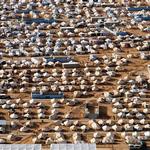Call for papers
Organised by Tamirace Fakhoury (University of Aalborg), Sarah Tobin and Kjersti G. Berg (CMI)
In the wake of Syrian mass displacement, much literature has focused on analyzing refugee hosting in key regional refugee-hosting states such as Lebanon, Jordan, and Turkey, or further afield focusing on EU member states or traditional resettlement countries such as Canada and the USA. Less emphasis has been placed on “unusual”, unlikely places or what Gustaffson (2019) frames as “unexpected havens”[1] to which Syrian refugees have fled. Examples include journeys to the island of Cyprus, Russia, Belarus or to unexpected places such as Sudan or Gaza, whose collective numbers constitute nearly 300,000 Syrians.[2] The two latter, usually depicted as war-torn and unattractive destinations, rarely figure in international discourse on refuge and sanctuary. This literature trend, which seeks to capture refugee destinations either in accordance with geographical contiguity or the degree of attractiveness/affluence of the hosting country is not restricted to Syrian displacement.
A case in point is the focus on understanding Palestinians’ displacement either in Lebanon, Jordan or in certain EU member states such as Germany and Denmark or in the USA, considered as desirable and attractive destinations. This has occurred though Palestinians have searched for routes and destinations outside of the “beaten path”. We cite for instance Palestinian migrations in Latin America, in Eastern Europe, Russia and in Southeast Asian countries including Malaysia and Indonesia. Almost no analysis has been carried on such itineraries.
Departing from these observations, our special issue seeks to shed light on under- researched and under-theorized refugee itineraries, destinations, choices, and aspirations. We seek to account for and desilence knowledge on what we frame as “non-iconic” places of refuge, defined both as unexpected, “off the radar” or less attractive destinations for refuge.
To that end, we call for contributions that shed light on unusual places of refuge. Contributions are encouraged to explore some of these questions:
- What drives displaced individuals to go to unusual or unexpected places of refuge, those that seem at first glance “off the beaten track” or less desirable/attractive in terms of refugee hosting?
- What makes these places of refuge unexpected? How can we understand their “unexpectedness”? According to what and whose framework are they unusual or unexpected?
- How do these unexpected trajectories and destinations of refuge put into question traditional analytical frameworks that explain onward migration and the search for durable solutions?
- How do we debunk the traditional argument or the literature bias that refugees either flee to neighboring countries or aspire to reach affluent nations in the Global North?
This special issue would have manifold contributions:
Theoretically, the SI unpacks the traditional push-pull model that assumes that asylum seekers and displaced individuals strive to reach destinations that are in line with rational considerations and choices. Instead, it argues that the push-pull model is conditioned by a myriad of factors that require accounting for contingencies, multiple, blocked, and derailed journeys as well as the endless quest for destinations. Second, the SI seeks to go beyond the static conceptualization of durable solutions (return, resettlement, or integration), showing for instance how refugees search for options such as self-settlement. Third, it seeks to correct the research bias that refugees either choose their destinations in accordance with geographical contiguity or degree of attractiveness of the “migration state.”
Empirically, the SI aims to provide in-depth case studies relating how and why refugees embark on unlikely places of refuge. These case studies would provide insight into the geospatial dynamics and confluence of factors as well as drivers that fashion refugees’ journeys and choices. But they would also shed light on refugees’ agency or their ability to envision and re-envision new spaces of sanctuary.
From a policy perspective, the SI would debunk several policy paradigms that have shown their limitations. Europe has in the last years tremendously invested in externalizing and containing migration in the hope that displaced individuals stay afar. The UK’s recent decision to externalize asylum to Rwanda, and Denmark’s adoption of a law that allows such externalization are cases in point. Contrary to what policy makers affirm, however, containment does not stop refugees’ quest for alternative journeys. Displaced individuals seek less familiar, convoluted, and ‘far from the beaten path’ routes and destinations. At the same time, policies of containment spur refugees to seek routes and destinations that are associated with necropolitics, wars and various risks.
Last, in its response to Ukrainian, Venezuelan, Syrian and Afghan displacement(s), the refugee regime has focused on devising collaborative agreements with key regional host countries that arise as “usual suspects” in refugee diplomacy. Yet there is almost no emphasis on developing policy instruments on displacement with places considered to be “off the register”. What does this say about inclusiveness in the international refugee regime? And how can our research on unlikely places of refuge correct the flaws of policy instruments including the Global Compacts and how global they are?
Timeline:
Submission of abstracts: 30. August 2022
Communication to the authors regarded accepted abstracts: 30 September 2022
First drafts: 15 January 2023
Authors’ workshop: February 2023
Submission of second drafts: 1 May 2023
Tamirace Fakhoury: talfa@dps.aau.dk
Sarah Tobin: sarah.tobin@cmi.no
Kjersti G. Berg: kjersti.berg@cmi.no
[1] See Jenny Gustaffson, Sudan, an Unexpected Haven for Syrian Refugees, Orient XXI (orientxxi.info), 9 April 2019
[2] Around 12,000 are reported to be in Cyprus, 9,100 in Russia, 1,000 in Belarus, 250,000 in Sudan and 5,000 in Gaza.
Project


